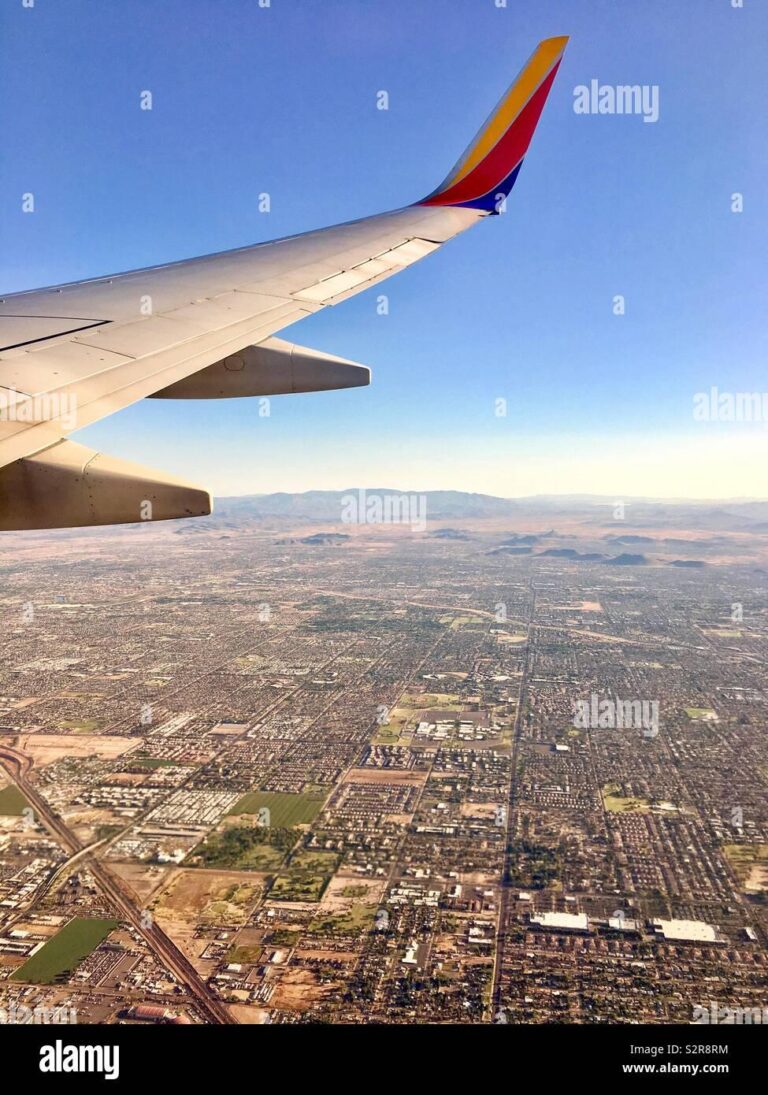Phoenix Sky Harbor International Airport has emerged as a critical hub for some of the most profitable flight routes operated by Southwest Airlines and other major carriers. With its strategic location in the Phoenix metropolitan area, the airport serves as a pivotal gateway connecting the West to key domestic destinations, attracting significant passenger traffic and driving revenue growth. This article explores the lucrative routes traversing Phoenix, highlighting their impact on the regional economy and the broader aviation industry.
Lucrative Flight Routes Boost Phoenix Metro’s Aviation Market
Phoenix’s strategic location has become a goldmine for the aviation sector, with several airline giants funneling their profitable domestic and international flights through the metro area. Southwest Airlines, in particular, capitalizes on the city’s growing demand, with routes connecting lucrative business and leisure destinations. This surge not only enhances passenger traffic but also injects significant revenue into Phoenix’s economy. Airlines are increasingly optimizing their schedules around key hubs in the city, signaling robust confidence in the metro’s growth as a critical node in the U.S. air travel network.
Several factors contribute to Phoenix’s rising prominence, including competitive airport fees and a growing population base demanding convenient travel options. The city’s connectivity is further bolstered by a mix of non-stop and connecting flights, appealing to both corporate and vacation travelers. Below is a snapshot of some of the most lucrative flight corridors that support this aviation boom:
- Phoenix to Dallas: Business-heavy route with high passenger turnover.
- Phoenix to Denver: Popular for connecting flights and regional access.
- Phoenix to Las Vegas: A top leisure route boasting strong weekend traffic.
- Phoenix to San Diego: High-frequency flights driven by both tourism and tech industry ties.
| Route | Airlines Operating | Average Daily Flights | Passenger Load Factor |
|---|---|---|---|
| Phoenix – Dallas | Southwest, American | 15 | 85% |
| Phoenix – Denver | Southwest, United | 12 | 82% |
| Phoenix – Las Vegas | Southwest, Spirit | 10 | 88% |
| Phoenix – San Diego | Southwest, Alaska | 8 | 80% |
Southwest Airlines Dominates Key Profit-Generating Flights Through Phoenix
Southwest Airlines continues to leverage Phoenix Sky Harbor International Airport as a strategic hub, commanding a significant portion of the market on routes known for high profitability. These flights, connecting Phoenix to major business and leisure destinations, generate substantial revenue due to strong passenger demand and frequent service schedules. By effectively capitalizing on Phoenix’s geographic position, Southwest not only boosts its market share but also reinforces its competitive edge against rival carriers.
Key destinations serviced through Phoenix highlight a pattern of lucrative travel corridors that influence airline route planning nationwide. The busiest and most profitable flights include nonstop flights to:
- Los Angeles (LAX) – tapping into the large entertainment and tech markets
- Las Vegas (LAS) – attracting leisure travelers and business conferences
- Dallas (DFW) – connecting two major Southwest hubs for business traffic
- Denver (DEN) – capturing demand from outdoor enthusiasts and energy sector professionals
| Route | Average Monthly Passengers | Profit Margin |
|---|---|---|
| Phoenix – Los Angeles | 75,000 | 22% |
| Phoenix – Las Vegas | 60,000 | 20% |
| Phoenix – Dallas | 55,000 | 18% |
| Phoenix – Denver | 48,000 | 17% |
Competitive Strategies Adopted by Airlines Operating in Phoenix Hub
Southwest Airlines leverages its Phoenix hub by emphasizing frequency, affordable fares, and a broad network that connects numerous secondary markets. Its competitive edge largely stems from a robust loyalty program that incentivizes repeat travelers alongside strategic partnerships with regional carriers, creating seamless travel experiences across the Sun Belt. Southwest’s flexibility with open seating policies and rapid turnaround times further enhance its appeal in the competitive Phoenix market, frequently outpacing rivals on domestic routes.
Other carriers operating in Phoenix adopt various strategies to carve out market share. Legacy airlines emphasize premium services, including enhanced in-flight amenities and loyalty rewards targeting business travelers, while integrating their global alliances to extend reach beyond domestic flights. Low-cost competitors focus heavily on lean operations, ultra-low fares, and secondary airport access nearby to attract budget-conscious travelers. Below is a snapshot comparison of some key competitive approaches:
| Airline | Key Strategy | Target Market | Phoenix Strength |
|---|---|---|---|
| Southwest Airlines | Frequency & Price Leadership | Leisure & Budget Travelers | Extensive Domestic Network |
| American Airlines | Premium Service & Alliance | Business Travelers | Transcontinental Connections |
| Allegiant Air | Ultra-Low Cost & Secondary Airports | Price Sensitive Flyers | Leisure Destinations |
| Delta Air Lines | International Alliance & Comfort | Global Business | Hub Expansion Plans |
Recommendations for Travelers Seeking Value on Arizona-Connected Flights
Travelers aiming to maximize their budget while booking flights connected to Phoenix’s metro hubs should consider several strategic approaches. One effective tactic is to leverage the competitive market dominated by Southwest Airlines alongside other carriers operating in the area. Flexible scheduling often opens doors to cheaper fares, particularly during off-peak hours or mid-week travel. It’s also prudent to monitor departure and arrival airports around Phoenix, such as Phoenix Sky Harbor International and nearby regional airports, for pricing discrepancies that might yield significant savings.
Additionally, savvy flyers should keep an eye on the following tips to unlock the best value:
- Book early, but review fares regularly—airlines frequently adjust prices based on demand and seasonality.
- Utilize fare comparison tools focusing on flights connecting through Phoenix to identify alternate routes.
- Consider layovers strategically—sometimes adding a stopover in Phoenix can reduce total travel costs substantially.
- Sign up for airline newsletters and alerts to receive exclusive deals directly from Southwest and other carriers.
| Airline | Popular Routes via Phoenix | Estimated Savings |
|---|---|---|
| Southwest Airlines | Phoenix–Dallas, Phoenix–Denver | Up to 25% |
| American Airlines | Phoenix–Chicago, Phoenix–New York | Up to 15% |
| Alaska Airlines | Phoenix–Seattle, Phoenix–San Diego | Up to 20% |
To Wrap It Up
As Phoenix continues to grow as a major travel hub, its strategic location and strong demand for both business and leisure travel ensure that lucrative routes will remain a key focus for Southwest and other airlines passing through the metro area. Industry watchers will be keeping a close eye on how these carriers adapt their networks to capitalize on Phoenix’s expanding market, shaping the future of air travel in the region.







